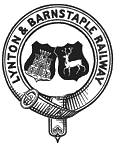
Chumhill railway accident
Encyclopedia

Lynton and Barnstaple Railway
The Lynton & Barnstaple Railway opened as an independent railway in May 1898. It was a single track narrow gauge railway slightly over long running through the rugged and picturesque area bordering Exmoor in North Devon, England. Although opened after the 1896 Light Railways Act came into force,...
maintained an exemplary safety record throughout its short existence, from 1898 to 1935, and no passengers or members of the public were ever killed or injured.
Overview
There were, however, two accidents resulting in fatalities to railway employees. The other was at Braunton RoadBraunton Road railway accident
The Lynton & Barnstaple Railway maintained an exemplary safety record throughout its short existence from 1898 to 1935, with no passenger or member of the public having ever been injured or killed. There were, however, two accidents resulting in fatalities to railway employees.On the morning of...
.
On 26 February 1913, four men of the Chelfham Bratton track gang were travelling in wagon No. 10 - a 4-ton open. They were in possession of the token and the wagon contained leaves and debris collected from trackside cesses. Whilst running down the 1 in 50 gradient from Bratton Fleming
Bratton Fleming railway station
Bratton Fleming was a station on the Lynton and Barnstaple Railway, a narrow gauge line that ran through Exmoor from Barnstaple to Lynton and Lynmouth in North Devon. The station served the village of Bratton Fleming. It opened with the line on 7 March 1898, and closed with it after service on 29...
to Chelfham
Chelfham railway station
Chelfham was a station on the Lynton and Barnstaple Railway, a narrow gauge line that ran through Exmoor from Barnstaple to Lynton and Lynmouth in North Devon. The station stood at the head of the spectacular Chelfham Viaduct, and served the village of Chelfham below. It opened with the line on 7...
, the speed increased and the vehicle's brakes were unable to control the descent. Upon reaching a sharp reverse curve by bridge 25, the wagon left the track, coming to rest at the foot of the bank.
George Barrow was killed outright and William Welch died a few days later on 2 March. They were both buried in Bratton Fleming churchyard. The two men who survived, Foreman Ganger George Dymond and F Dinnicombe, attributed the accident to wet leaves on the line.
The wagon was recovered, repaired and returned to service, with the replacement planks left unpainted for some time after the accident.

